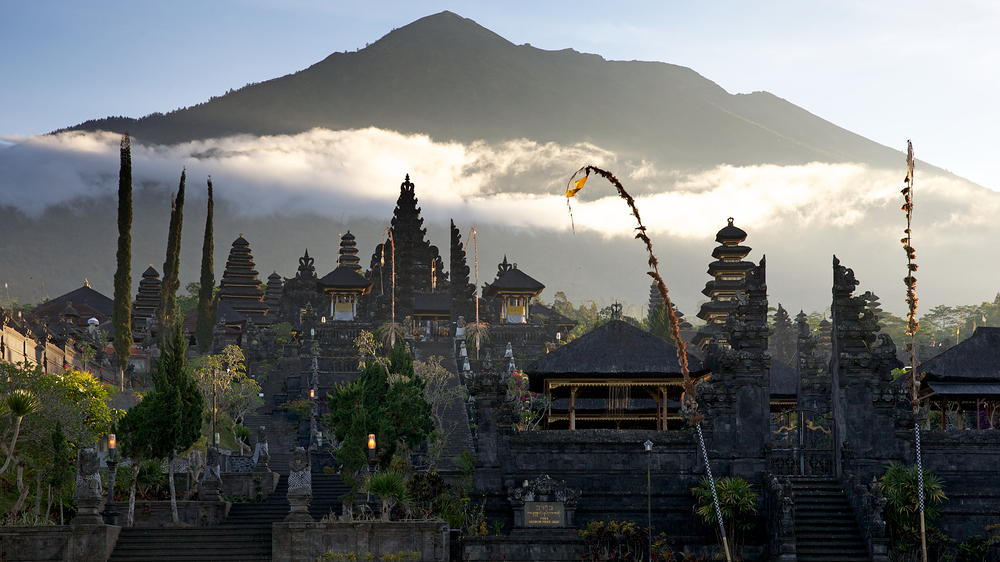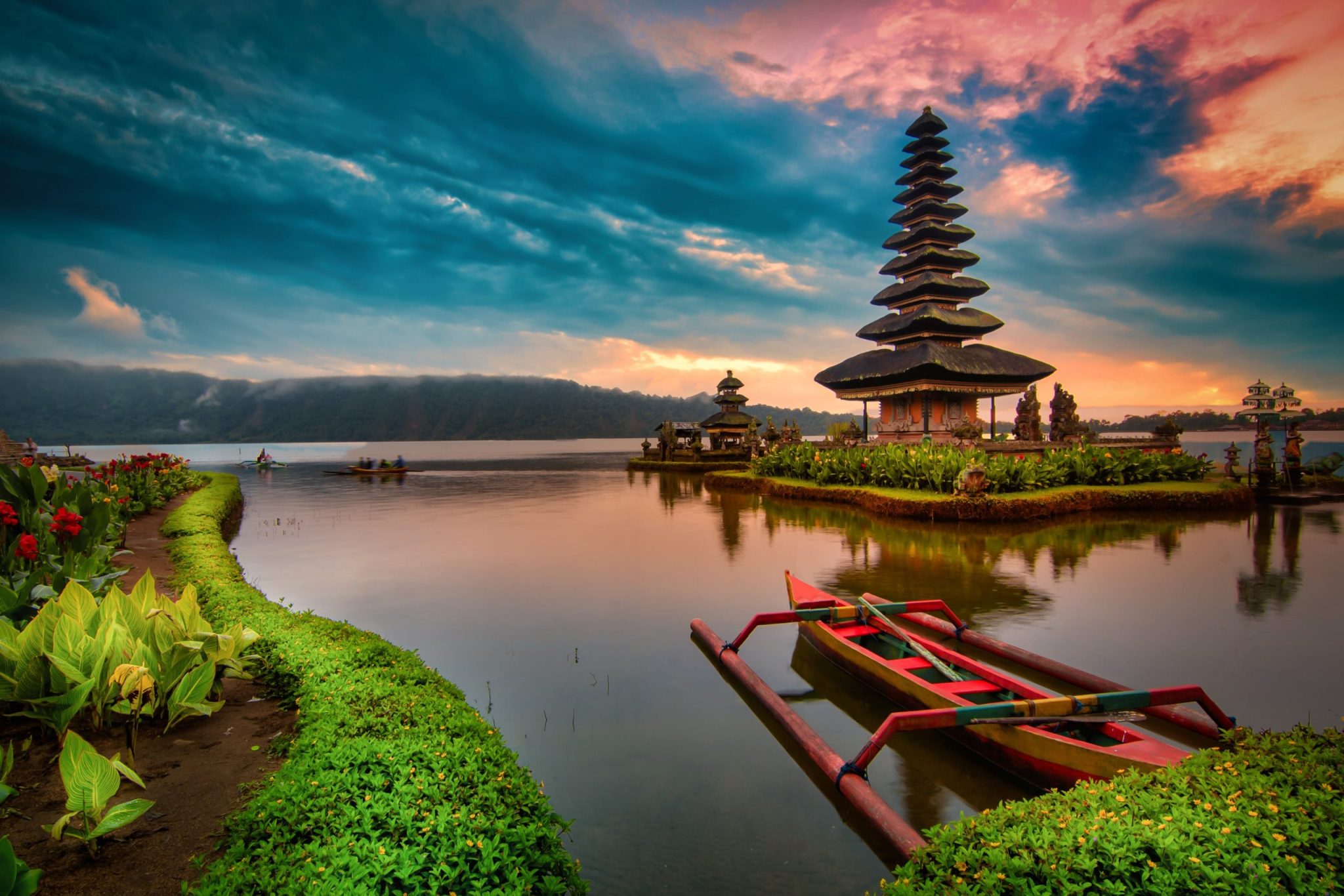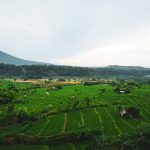Bali, Indonesia, is known for its numerous temples, each with its unique architectural style and cultural significance. Here are a few notable temples in Bali.
Famous Temple in Bali
Beji Amerta Gangga Temple
Beji Amerta Gangga Temple, also known as Pura Beji Sangsit, is a significant Hindu temple located in the village of Sangsit, in the northern part of Bali, Indonesia. This temple is renowned for its unique and intricate architecture and its role in Balinese Hindu rituals and ceremonies.
Uluwatu Temple
Uluwatu Temple, also known as Pura Luhur Uluwatu, is a Balinese sea temple located on the southwestern tip of the Bukit Peninsula in Bali, Indonesia. This temple is one of the most famous and iconic landmarks on the island and is renowned for its stunning clifftop location, Balinese architecture, and cultural significance. The temple is one of Bali’s important sea temples and is dedicated to the spirits of the sea, known as Dewa Baruna or Bhatara Segara. Balinese Hindus believe that these deities protect the island from evil spirits. Uluwatu Temple is not only a religious and cultural site but also a popular tourist destination in Bali. Its combination of natural beauty, cultural significance, and traditional performances makes it a must-visit for those traveling to the island.
Ulun Danu Beratan Temple
Ulun Danu Beratan Temple, officially known as Pura Ulun Danu Beratan, is another iconic and highly regarded temple located in Bali, Indonesia. This temple complex is situated on the shores of Lake Bratan in the mountains of Bedugul, in the central part of the island. It is one of the most picturesque and serene temples in Bali, known for its stunning setting and unique architecture. The temple’s architecture is distinctive, with multi-tiered pagodas (meru towers) and shrines made of black thatch and red-brick. The temple’s roofs are adorned with traditional Balinese thatchwork, and it has a peaceful and harmonious appearance. One of the most iconic features of Ulun Danu Beratan Temple is the illusion of floating on the lake. During the wet season when the lake’s water level rises, the temple appears to be floating due to the submerged lower sections.
Taman Ayun Temple
Taman Ayun Temple, also known as Pura Taman Ayun, is a beautiful and historically significant Balinese Hindu temple located in the village of Mengwi in the Badung Regency of Bali, Indonesia. The temple is one of the island’s most important and well-preserved architectural landmarks, known for its distinctive design and lush surroundings. The temple is known for its unique architectural style, which features a series of courtyards and multi-tiered meru towers. The central courtyard, called the Jaba Utama, is surrounded by a moat with a series of gates and bridges leading to the inner sanctum. The towering pagoda-like meru shrines are adorned with intricate carvings and thatched roofs. The temple is open to visitors, and tourists are welcome to explore its courtyards, gardens, and architecture. It is also a popular spot for photographers and cultural enthusiasts.
Tanah Lot
Tanah Lot is a famous temple located on the southwestern coast of Bali, Indonesia. It is one of the most iconic and photographed landmarks on the island. The temple is situated on a large offshore rock formation and is surrounded by the Indian Ocean. What makes Tanah Lot Temple so unique is its stunning location. It stands on a rock formation that becomes inaccessible during high tide, creating the illusion that the temple is floating on the sea. During low tide, visitors can walk to the temple. Tanah Lot is particularly famous for its breathtaking sunset views. Many tourists visit in the late afternoon to witness the temple against the backdrop of a colorful sunset.
Goa Gajah
Goa Gajah, also known as the Elephant Cave, is a historical and archaeological site located on the island of Bali, Indonesia. The site is named Elephant Cave due to its entrance, which is carved to resemble an elephant’s head. The cave entrance is decorated with intricate stone carvings and a menacing figure. The main attraction at Goa Gajah is the cave itself, which consists of a central chamber with a statue of Ganesha, the Hindu elephant-headed deity, and other stone carvings. The cave also features a bathing pool with statues and fountains.
Taman Saraswati Temple
Taman Saraswati Temple, also known as Pura Taman Saraswati, is a beautiful temple located in the heart of Ubud, a prominent cultural and artistic town in Bali, Indonesia. This temple is dedicated to the Hindu goddess Saraswati, who is regarded as the goddess of knowledge, arts, music, and learning in Hinduism. Saraswati is often depicted holding a musical instrument and a book. Taman Saraswati Temple is renowned for its striking water garden. To reach the temple, visitors must walk through a path surrounded by lotus ponds filled with blooming lotus flowers, creating a picturesque and serene atmosphere.

Besakih Temple
Besakih Temple, often referred to as Pura Besakih, is the largest and most important Hindu temple complex in Bali, Indonesia. It is often called the Mother Temple of Bali due to its spiritual significance and the fact that it serves as the paramount religious center for Balinese Hindus. The temple complex is dedicated to the Hindu trinity of Brahma (the creator), Vishnu (the preserver), and Shiva (the destroyer). It is a place of worship and pilgrimage for Balinese Hindus and is considered the holiest site on the island. Besakih Temple is not a single temple but a sprawling complex comprising numerous shrines, pavilions, and courtyards. These structures are arranged in a stepped terraced layout, making it an impressive architectural and religious site. The central and most significant temple within the complex is Pura Penataran Agung. This temple is dedicated to Shiva and is the main focus of worship during major festivals and ceremonies.
Lempuyang Temple
Lempuyang Temple, also known as Pura Lempuyang Luhur, is a renowned Hindu temple complex located on the slopes of Mount Lempuyang in East Bali, Indonesia. It is considered one of the holiest and most picturesque temples in Bali. The temple complex is set in a stunning natural environment, surrounded by lush forests and offering panoramic views of Mount Agung, Bali’s highest volcano, which is considered sacred by the Balinese. To reach the main temple, visitors must climb a long staircase consisting of over 1,700 steps that wind through the forested slopes of Mount Lempuyang. The hike can be challenging, but it offers a spiritual and scenic experience. Due to its stunning location and views, Lempuyang Temple has become a popular spot for sunrise photography. The Gates of Heaven frame Mount Agung perfectly during sunrise, creating a dramatic and Instagram-worthy backdrop.
Gunung Kawi Temple
Gunung Kawi Temple is an ancient temple complex located in Tampaksiring, Bali, Indonesia. It is known for its unique and dramatic rock-cut shrines and is considered one of the oldest and most important archaeological sites on the island. The shrines at Gunung Kawi are carved in a style reminiscent of the candi (temple) architecture found in Java. They feature intricate carvings and are considered a significant example of ancient Balinese stone architecture. To reach the temple complex, visitors must descend a steep staircase leading to the Pakerisan River. After crossing a bridge over the river, another set of stairs leads to the shrines. The river crossing and the surrounding scenery add to the mystique of the site.
Ling Gwang Kiong
Ling Gwan Kiong is a well-known Chinese temple located in Singaraja, North Bali, Indonesia. This temple is an important religious and cultural site for the Chinese community in Bali and serves as a place of worship, cultural preservation, and community gathering. The temple also hosts various festivals and celebrations throughout the year, including Chinese New Year and other important cultural events. It’s not only a religious site but also a significant cultural and historical attraction in North Bali.
Petitenget Temple
Petitenget Temple is situated along the southwestern coast of Bali, near the popular beach resorts of Seminyak and Kerobokan. Its coastal location provides stunning ocean views. The temple is dedicated to Dewi Petitenget, a Balinese Hindu goddess associated with the sea and fertility. Like many Balinese temples, Petitenget Temple features traditional Balinese architecture with intricate stone carvings and beautiful decorative elements. The temple’s distinctive black sand and bricks set it apart from some of the island’s other temples.
Gunung Lebah Temple
Gunung Lebah Temple, also known as Pura Gunung Lebah or Campuhan Temple, is a Hindu temple located in Ubud, Bali, Indonesia. It’s one of the oldest and most historically significant temples in the Ubud area. Gunung Lebah Temple is known for its sacred springs that are believed to have purifying properties. Devotees and visitors often come here to perform cleansing rituals and make offerings. Aside from its religious significance, the temple’s location offers stunning panoramic views of the Campuhan Ridge and lush, green rice terraces. Many visitors come for the scenic beauty in addition to its spiritual aspects.
Holy water Temple – Purification
Tirta Empul
Tirta Empul Temple, located in the village of Tampaksiring in the Gianyar Regency of central Bali, Indonesia, is one of the island’s most important and sacred temples. This temple is renowned for its holy spring water, which is believed to have strong purifying and healing properties, and it plays a significant role in Balinese Hindu rituals and ceremonies.
Tirta Gangga
Tirta Gangga is a stunning water palace located in the village of Ababi in the Karangasem Regency of Bali, Indonesia. This royal palace and garden complex is renowned for its beautiful and intricate architecture, serene ponds, and lush greenery.
Gunung Kawi Temple
Gunung Kawi Temple is an ancient temple complex located in Tampaksiring, Gianyar Regency, Bali, Indonesia. This temple is famous for its stunning rock-cut shrines and its historical and cultural significance. It is one of Bali’s most important archaeological sites. The main highlight of Gunung Kawi Temple is its impressive rock-cut shrines. There are ten shrines carved into the rock face, each standing about 7 meters high. These shrines are believed to be memorials for the Balinese King Anak Wungsu and his queens. The carvings are intricate and showcase the artistic skill of the ancient Balinese.






